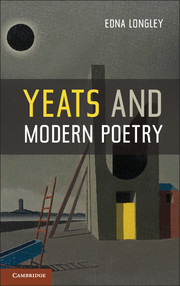Book contents
- Frontmatter
- Dedication
- Contents
- Preface
- Acknowledgements
- List of Abbreviations
- Chapter 1 Ireland as Audience: ‘To write for my own race’
- Chapter 2 Yeats and American Modernism
- Chapter 3 Intricate Trees: The Survival of Symbolism
- Chapter 4 ‘Monstrous familiar images’: Poetry and War, 1914–1923
- Chapter 5 Yeats’s Other Island
- Postscript
- Notes
- Index
Chapter 3 - Intricate Trees: The Survival of Symbolism
Published online by Cambridge University Press: 05 June 2014
- Frontmatter
- Dedication
- Contents
- Preface
- Acknowledgements
- List of Abbreviations
- Chapter 1 Ireland as Audience: ‘To write for my own race’
- Chapter 2 Yeats and American Modernism
- Chapter 3 Intricate Trees: The Survival of Symbolism
- Chapter 4 ‘Monstrous familiar images’: Poetry and War, 1914–1923
- Chapter 5 Yeats’s Other Island
- Postscript
- Notes
- Index
Summary
This chapter again triangulates Yeats with two younger contemporaries: the Anglo-Welsh Edward Thomas (1878–1917) and the American Wallace Stevens (1879–1955). To link these poets (who never met) is to draw out Yeats’s side of the dialectics traced in Chapter 2. All three can be said to conceive form as ‘full, sphere-like, single’, and I will argue that the term ‘Symbolism’ illuminates (and is illuminated by) their common aesthetic bearings. Thomas’s Poems (1917) and Last Poems (1918) and Stevens’s Harmonium (1923) are largely absent from the foundational story of modern poetry, perhaps because both poets wrote or published belatedly. Yet belatedness – finding ways round or through nineteenth-century poetic modes – is itself part of the story. Stevens has often been compared to Yeats; Thomas seldom, despite the felt affinities suggested by his reviews of Yeats’s work. Even so, a Yeats-Stevens axis has rarely been central to critical narratives – at least since New Criticism receded. Edward Clarke can reasonably claim that his recent study, The Later Affluence ofW.B. Yeats and Wallace Stevens, ‘is the first to concentrate on Yeats and Stevens together in ... detail’. Modernist criticism has played its part in obscuring the parallels between three poets whose relation to the literary past, specifically to Romantic poetry and 1890s Aestheticism, is more evolutionary than revolutionary.
- Type
- Chapter
- Information
- Yeats and Modern Poetry , pp. 68 - 105Publisher: Cambridge University PressPrint publication year: 2013



